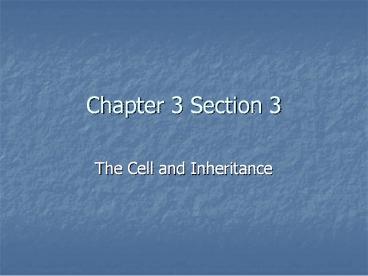Chapter 3 Section 3 - PowerPoint PPT Presentation
1 / 33
Title:
Chapter 3 Section 3
Description:
... XY Design a Punnett Square to calculate the probability of a man and woman having a baby girl of baby boy ... add cells and growth Prepare cells for ... – PowerPoint PPT presentation
Number of Views:94
Avg rating:3.0/5.0
Title: Chapter 3 Section 3
1
Chapter 3 Section 3
- The Cell and Inheritance
2
Walter Sutton
- American scientist
- Studied sex cells (egg and sperm) to determine
how chromosomes are involved in the formation. - Studied grasshoppers
3
Suttons Work
- Grasshoppers have 24 chromosomes in body cells.
- Their sex cells (egg and sperm) each have 12
chromosomes. - Result egg cell sperm cell fertilized egg
with 24 chromosomes
4
Suttons Conclusion
- Genes are located on chromosomes
- Genes passed from parent to offspring on
chromosomes - Became known as Chromosome Theory of Inheritance
5
(No Transcript)
6
Human Cells
- Human body cells contain 46 chromosomes
(23 pairs) - Sex cells (egg and sperm) contain 23 chromosomes
- The 23rd pair of chromosomes determines the sex
of an individual. - Female genotype XX
- Male genotype XY
- Design a Punnett Square to calculate the
probability of a man and woman having a baby girl
of baby boy
7
Karyotype
- Definition picture of all the chromosomes in a
cell arranged in pairs - Is this karyotype from a male or female?
8
Where is there a problem?
9
Meiosis
- Definition process by which the number of
chromosomes is reduced by half to form sex cells - Similar to mitosis but the cell divides twice.
- Resulting sex cells have half the amount of
chromosomes as other body cells.
10
Meiosis vs. Mitosis
11
Meiosis Video Clip
http//www.youtube.com/watch?vqCLmR9-YY7o
12
Mitosis vs. MeiosisCreate a T chart to compare
and contrast mitosis and meoisis for the
following characteristics.
- Involved in what type of reproduction
- Type of cells which undergo the process
- Reason for this process to occur
- Stages involves (list all of the stages)
- Number of cells produced
- Number of chromosomes in the resulting cells
- How does resulting cell compare to the parent
cell genetically?
13
Mitosis Meiosis
Reproduction Asexual Sexual
Cell Type? Body cells Sex cells (Gametes)
Reason? Replace old cells, add cells and growth Prepare cells for production of new offspring.
Stages involved 4 stages Prophase, Metaphase, Anaphase, Telophase 8 Stages Prophase (I, II), Metaphase (I, II), Anaphase (I, II), Telophase (I, II),
Number of cells produced 2 4
Number of chromosomes in resulting cells? Full Set (Diploid) Human 46 Half set (haploid) Human 23
How do daughter cells compare to parent cells? Identical DNA (clone) Different DNA mixture from 2 parents.
14
Protein Structure
unwind
15
The Genetic Code
- What are the 4 different nitrogen bases in a DNA
molecule? How do they pair? - Adenine pairs with Thymine
- Cytosine pairs with Guanine
16
Base Pairing The secret to code!!
Adenine pairs with Thymine
Guanine pairs with Cytocine
17
The Genetic Code
- The order of nitrogen bases along a gene forms a
Genetic Code that specifies what type of protein
will be produced.
18
The Genetic Code
ATTCGGTG
Genes make proteins Proteins make YOU!!
19
The Genetic Code (cont.)
- What are the building blocks of protein?
- A group of three nitrogen bases codes for a
specific amino acid. - The production of proteins is called protein
synthesis. - Two steps Transcription and Translation
20
Introducing a new player - RNA
21
DNA vs. RNA - Chart
22
The Genetic Code
23
Protein synthesis takes place on the ribosome.
24
Two types of RNA
25
(No Transcript)
26
Protein Synthesis
http//highered.mcgraw-hill.com/sites/0072943696/s
tudent_view0/chapter3/animation__how_translation_w
orks.html
27
Mutation
- Definition mistake that occurs in one gene of a
chromosome. This causes the cell to produce an
incorrect protein which results in a different
physical trait or phenotype.
28
Mutations
- Mutations are usually random and can be
- Harmful causes harm to the organism
- Helpful helps the organism to survive
- Neither harmful or helpful.
- Mutations can also be caused by environmental
hazards. - These are usually harmful
29
Mutations
The mice ran away.
Substitution Mutation
The rice ran away.
Deletion Mutation
Thei cera naway.
The migukce ran away.
Insertion Mutation
30
Steps of Protein Synthesis
- DNA unzips between the Nitrogen Base pairs
- Genetic info. from DNA is copied by the mRNA
which leaves the nucleus and attaches to a
ribosome in the cytoplasm.
31
Steps of Protein Synthesis (cont.)
- Transfer RNA (tRNA) picks up amino acids
according to the mRNA code of nitrogen bases. - Each tRNA molecule attaches the amino acid to the
growing protein chain. - (Show overhead diagram and video clip)
32
Protein Synthesis
- The genetic messenger is called messenger RNA (or
mRNA). - mRNA carries the DNA code from the nucleus out
into the cells cytoplasm to the ribosomes where
proteins are produced. - This process is called TRANSCRIPTION
33
Questions
- Why cant DNA leave the nucleus to produce
proteins? - Why is it important for meiosis to occur? What
would happen if human sex cells had 46
chromosomes instead of 23?































